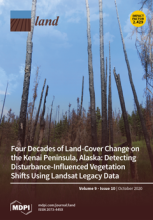/ library resources
Showing items 1 through 9 of 4648.Monitoring of irrigated land cover is important for both resource managers and farmers. An operational approach is presented to use the satellite-derived surface temperature and vegetation cover in order to distinguish between irrigated and non-irrigated land.
A framework was developed to elucidate (1) the drivers of land degradation, (2) pressures, (3) local impacts and vulnerabilities and (4) adaptation strategies.
At the request of the Sri Lankan Government an assessment was designed and conducted as part of the development of the country’s national strategy on REDD+. The assessment involved applying criteria from the Voluntary Guidelines on the Responsible Governance of Tenure of Land, Fish
India is currently among the most affected countries by COVID19, recording over 6 million cases, by September 30 2020.
Across Alaska’s Kenai Peninsula, disturbance events have removed large areas of forest over the last half century. Simultaneously, succession and landscape evolution have facilitated forest regrowth and expansion.
Drastic growth of urban populations has caused expansion of peri-urban areas—the transitional zone between a city and its hinterland.
Mountainous regions are more sensitive to climatic condition changes and are susceptible to recent increases in temperature. Due to urbanization and land use/land cover (LULC) issues, Cameron Highlands has been impacted by rising land surface temperature (LST) variation.
There is a growing interest for scientists and society to acquire deep knowledge on the impacts from environmental disasters.
Paginação
Land Library Search
Through our robust search engine, you can search for any item of the over 73,000 highly curated resources in the Land Library.
If you would like to find an overview of what is possible, feel free to peruse the Search Guide.






